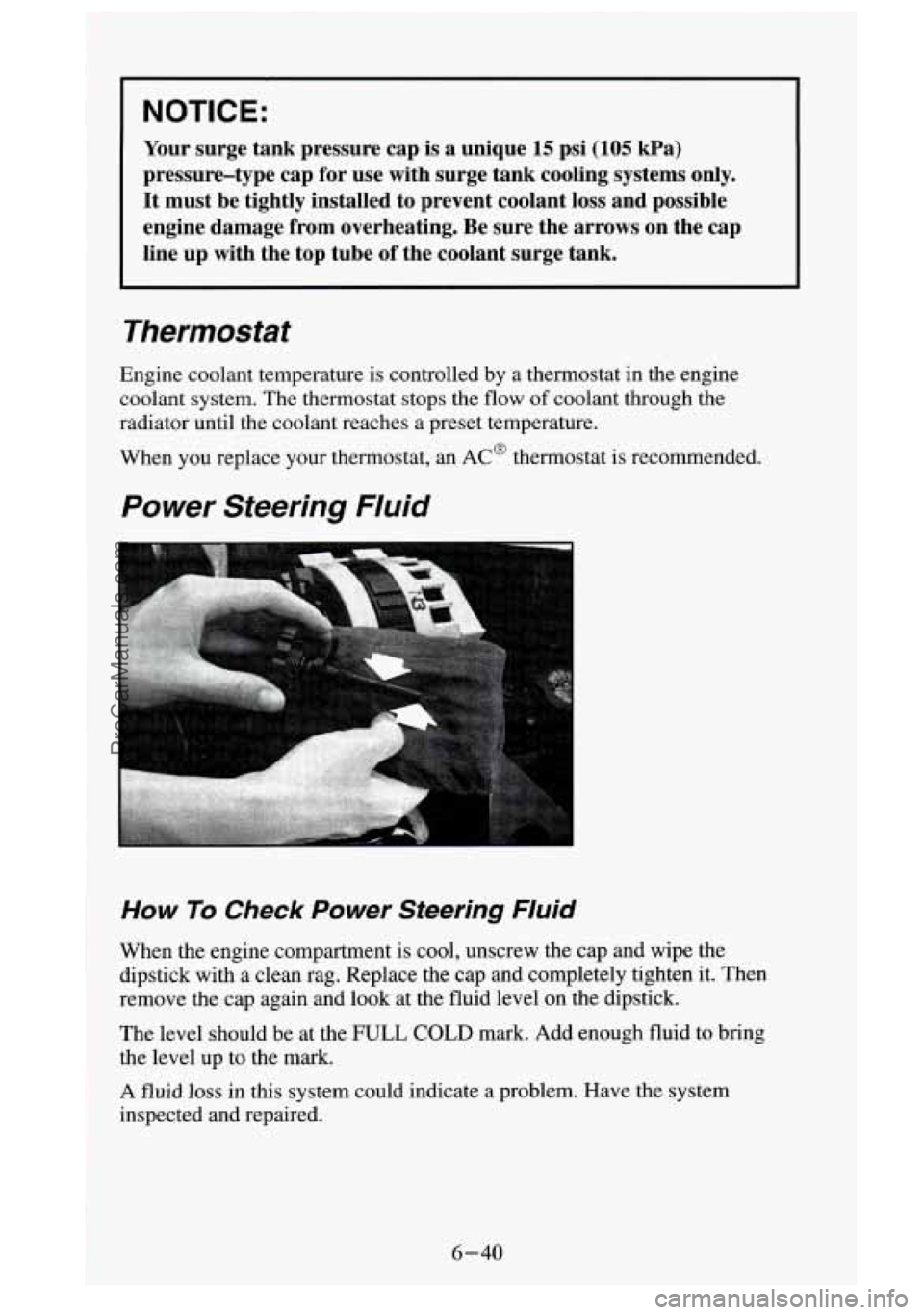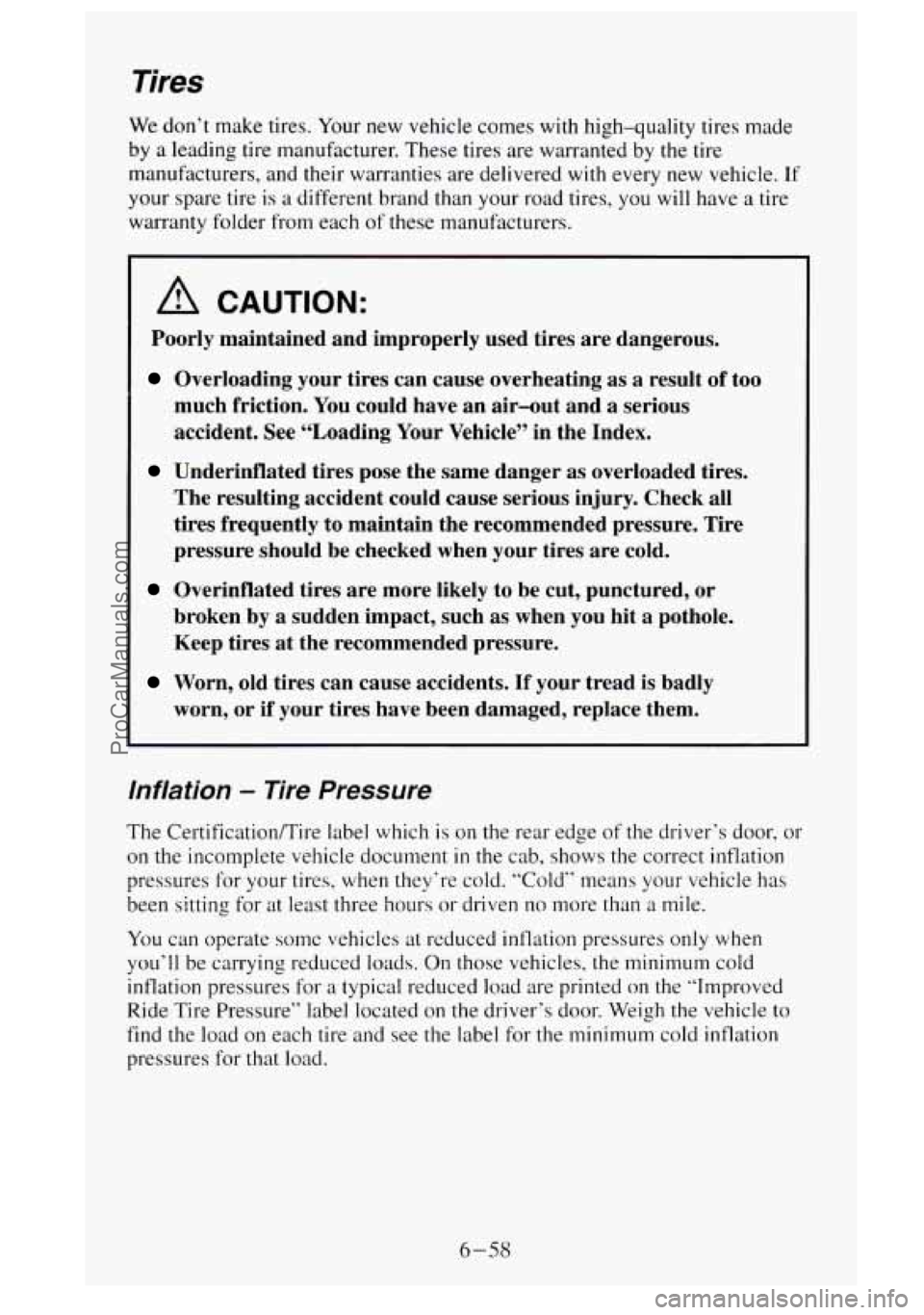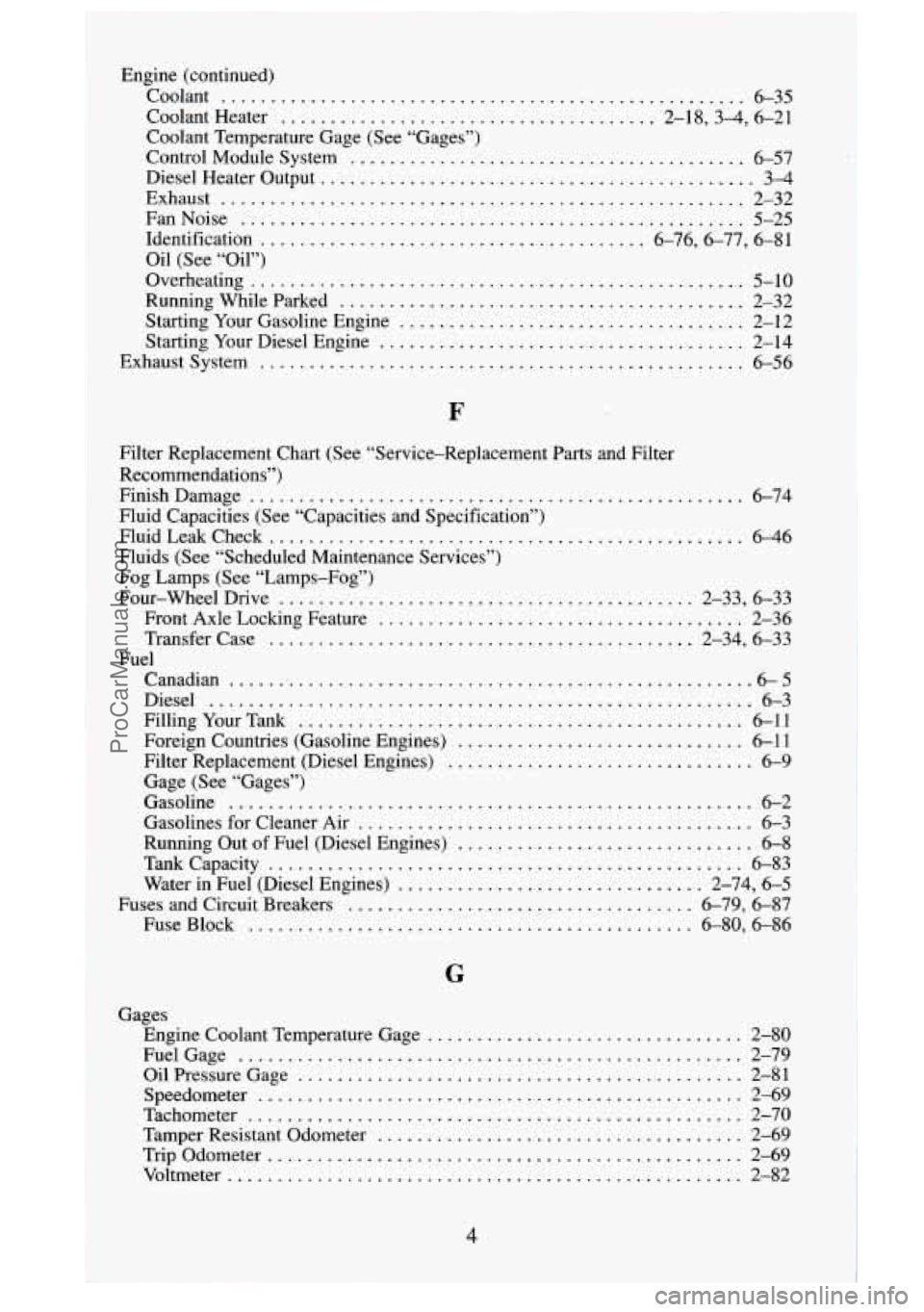Page 305 of 488
Radiator Pressure Cap - Gasoline Engine
The radiator pressure
cap must be tightly
installed with
the
arrows on the cap
lined up with the
overflow tube on the
radiator filler neck.
NOTICE:
Your radiator cap is a 15 psi (105 kPa) pressure-type cap and
must be tightly installed to prevent coolant loss and possible \
engine damage from overheating. Be sure the arrows
on the cap
line up with the overflow tube on the radiator filler neck.
Surge Tank Pressure Cap - Diesel Engine
The surge tank
pressure cap must be
tightly installed with
the arrows on the cap
lined up with the top
tube of the coolant
surge tank.
6-39
ProCarManuals.com
Page 306 of 488

NOTICE:
Your surge tank pressure cap is a unique 15 psi (105 kPa)
pressure-type cap for use with surge tank cooling systems only.
It must be tightly installed to prevent coolant loss and possible
engine damage from overheating. Be sure the arrows on the cap
line up with the top tube of the coolant surge tank.
Thermostat
Engine coolant temperature is controlled by a thermostat in the engine
coolant system. The thermostat stops the flow
of coolant through the
radiator until the coolant reaches a preset temperature.
When you replace your thermostat, an AC@ thermostat is recommended.
Power Steering Fluid
How To Check Power Steering Fluid
When the engine compartment is cool, unscrew the cap and wipe \
the
dipstick with a clean rag. Replace the cap and completely tighten it. Then
remove the cap again and look at the fluid level on the dips\
tick.
The level should be at the
FULL COLD mark. Add enough fluid to bring
the level
up to the mark.
A fluid loss in this system could indicate a problem. Have the system
inspected and repaired.
6-40
ProCarManuals.com
Page 324 of 488

Tires
We don’t make tires. Your new vehicle comes with high-quality tires made
by a leading tire manufacturer. These tires are warranted by the tire
manufacturers, and their warranties are delivered
with every new vehicle. If
your spare tire is a different brand than your road tires, you will have
a tire
warranty folder from each
of these manufacturers.
A CAUTION:
Poorly maintained and improperly used tires are dangerous.
Overloading your tires can cause overheating as a result of too
much friction. You could have an air-out and a serious
accident. See “Loading Your Vehicle” in the Index.
Underinflated tires pose the same danger as overloaded tires.
The resulting accident could cause serious injury. Check all
tires frequently to maintain the recommended pressure. Tire
pressure should be checked when your tires are cold.
Overinflated tires are more likely to be cut, punctured, or
broken by
a sudden impact, such as when you hit a pothole.
Keep tires
at the recommended pressure.
Worn, old tires can cause accidents. If your tread is badly
worn, or if your tires have been damaged, replace them.
Inflation - Tire Pressure
The Certification/Tire label which is on the rear edge of the driver‘s door, or
on the incomplete vehicle document in the cab, shows the correct inflation
pressures for your tires, when they’re cold. “Cold“ tneans your vehicle
has
been sitting for at least three hours or driven no more than a mile.
You can operate some vehicles at reduced inflation pressures only when
you’ll be carrying reduced loads. On those vehicles, the minimum cold
inflation pressures for
a typical reduced load are printed on the “Improved
Ride Tire Pressure” label located on the driver’s door. Weigh the vehicle to
find the load on each tire and see the label for the minimum cold inflation
pressures for that load.
6-58
ProCarManuals.com
Page 476 of 488

Engine (continued)
Coolant
..................................................... 6-35
Coolant Heater
...................................... 2.18.3-4. 6.21
Coolant Temperature Gage (See “Gages”)
Control Module System
........................................ 6-57
Diesel Heater Output
............................................ 34
Exhaust
..................................................... 2-32
FanNoise
................................................... 5-25
Identification
....................................... 6-76,677, 6-81
Oil (See “Oil”)
Overheating
.................................................. 5-10
RunningWhileParked
......................................... 2-32
Starting Your Gasoline Engine
................................... 2-12
Starting Your Diesel Engine
..................................... 2-14
Exhaustsystem
................................................. 6-56
F
Filter Replacement Chart (See “Service-Replacement Parts and Filter
Recommendations”)
FinishDamage
.................................................. 6-74
Fluid Capacities (See “Capacities and Specification”)
FluidLeakCheck
................................................ 646
Fluids (See “Scheduled Maintenance Services”)
Fog Lamps (See “Lamps-Fog”)
Four-WheelDrive
.......................................... 2-33, 6-33
Front Axle Locking Feature
..................................... 2-36
Transfer Case
........................................... 2-34, 6-33
Canadian
...................................................... 6-5
Diesel
....................................................... 6-3
FillingYourTank
............................................. 6-11
Fuel
Foreign Countries (Gasoline Engines)
............................. 6-11
Filter Replacement (Diesel Engines)
............................... 6-9
Gage (See “Gages”)
Gasoline
..................................................... 6-2
Gasolines for Cleaner Air
........................................ 6-3
Running Out of Fuel (Diesel Engines)
.............................. 6-8
Tankcapacity
................................................ 6-83
Water in Fuel (Diesel Engines)
............................... 2-74, 6-5
Fuses and Circuit Breakers ................................... 6-79, 6-87
FuseBlock
............................................. 6-80, 6-86
G
Gages Engine Coolant Temperature Gage
................................ 2-80
Oil Pressure Gage
............................................. 2-81
Tamper Resistant Odometer ..................................... 2-69
Trip Odometer
................................................ 2-69
FuelGage
................................................... 2-79
Speedometer
................................................. 2-69
Tachometer
.................................................. 2-70
Voltmeter
.................................................... 2-82
4
ProCarManuals.com